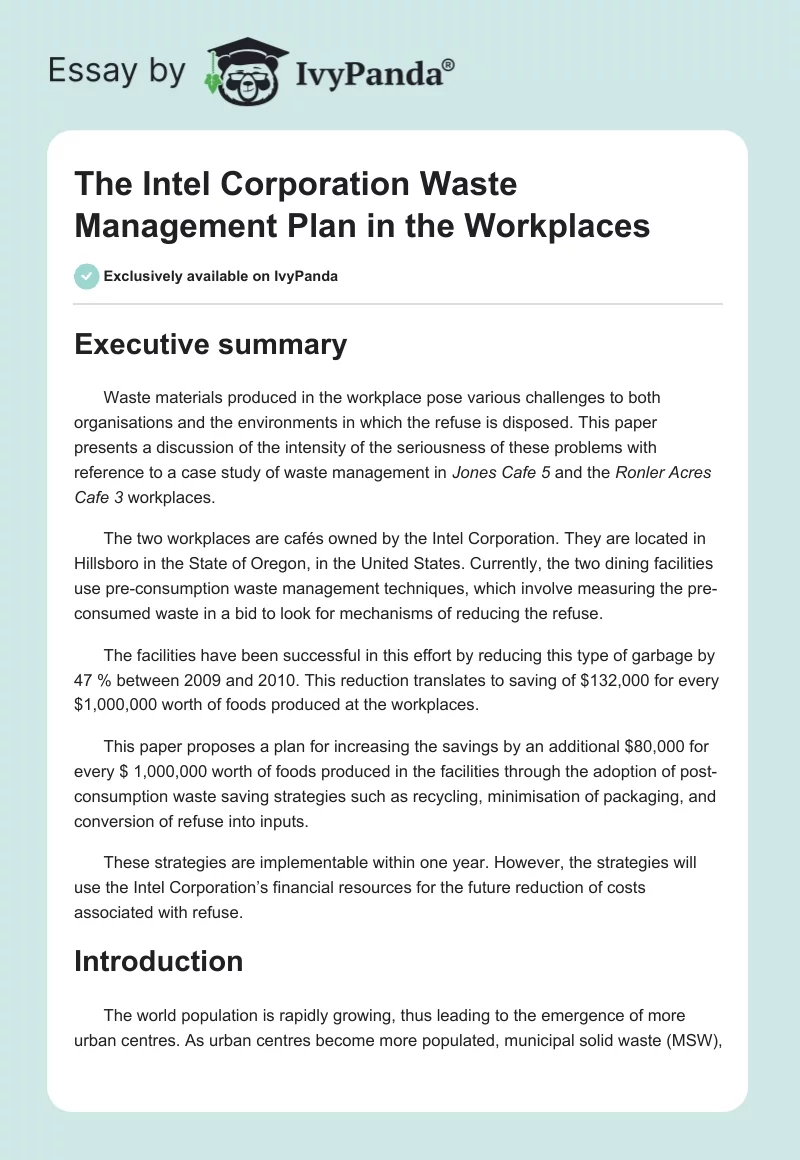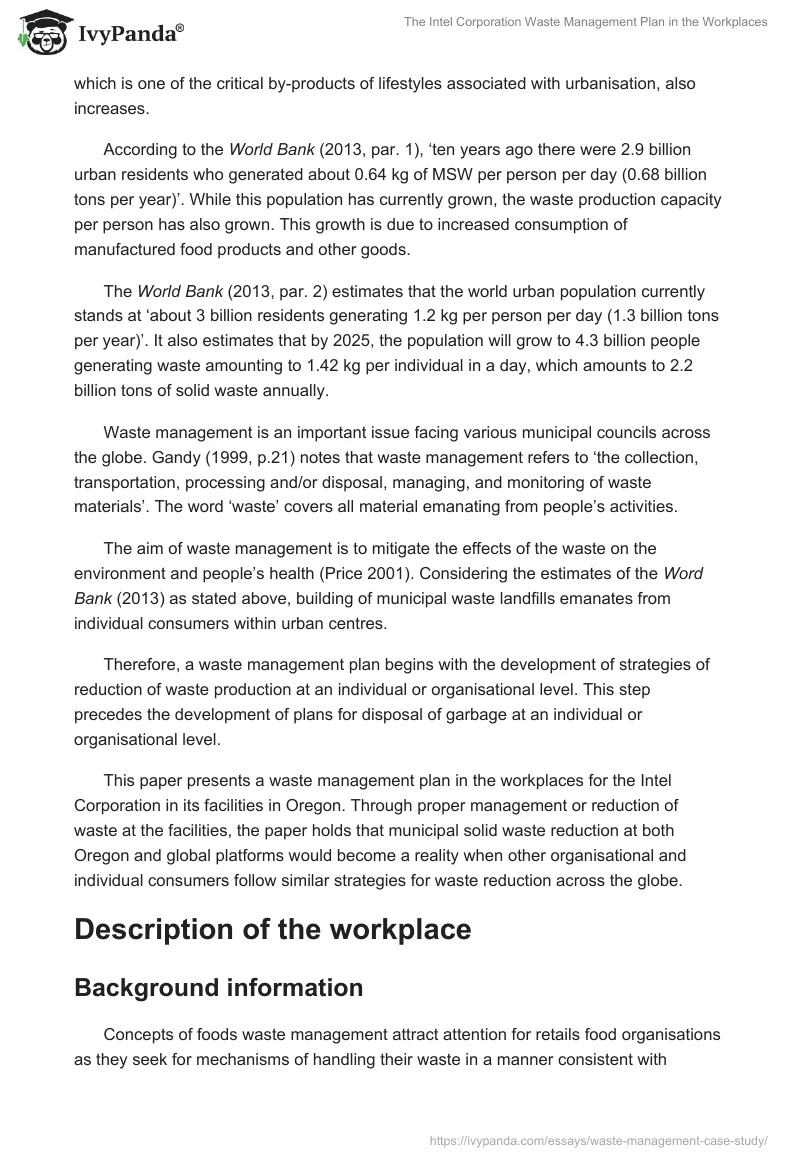Executive summary
Waste materials produced in the workplace pose various challenges to both organisations and the environments in which the refuse is disposed. This paper presents a discussion of the intensity of the seriousness of these problems with reference to a case study of waste management in Jones Cafe 5 and the Ronler Acres Cafe 3 workplaces.
The two workplaces are cafés owned by the Intel Corporation. They are located in Hillsboro in the State of Oregon, in the United States. Currently, the two dining facilities use pre-consumption waste management techniques, which involve measuring the pre-consumed waste in a bid to look for mechanisms of reducing the refuse.
The facilities have been successful in this effort by reducing this type of garbage by 47 % between 2009 and 2010. This reduction translates to saving of $132,000 for every $1,000,000 worth of foods produced at the workplaces.
This paper proposes a plan for increasing the savings by an additional $80,000 for every $ 1,000,000 worth of foods produced in the facilities through the adoption of post-consumption waste saving strategies such as recycling, minimisation of packaging, and conversion of refuse into inputs.
These strategies are implementable within one year. However, the strategies will use the Intel Corporation’s financial resources for the future reduction of costs associated with refuse.
Introduction
The world population is rapidly growing, thus leading to the emergence of more urban centres. As urban centres become more populated, municipal solid waste (MSW), which is one of the critical by-products of lifestyles associated with urbanisation, also increases.
According to the World Bank (2013, par. 1), ‘ten years ago there were 2.9 billion urban residents who generated about 0.64 kg of MSW per person per day (0.68 billion tons per year)’. While this population has currently grown, the waste production capacity per person has also grown. This growth is due to increased consumption of manufactured food products and other goods.
The World Bank (2013, par. 2) estimates that the world urban population currently stands at ‘about 3 billion residents generating 1.2 kg per person per day (1.3 billion tons per year)’. It also estimates that by 2025, the population will grow to 4.3 billion people generating waste amounting to 1.42 kg per individual in a day, which amounts to 2.2 billion tons of solid waste annually.
Waste management is an important issue facing various municipal councils across the globe. Gandy (1999, p.21) notes that waste management refers to ‘the collection, transportation, processing and/or disposal, managing, and monitoring of waste materials’. The word ‘waste’ covers all material emanating from people’s activities.
The aim of waste management is to mitigate the effects of the waste on the environment and people’s health (Price 2001). Considering the estimates of the Word Bank (2013) as stated above, building of municipal waste landfills emanates from individual consumers within urban centres.
Therefore, a waste management plan begins with the development of strategies of reduction of waste production at an individual or organisational level. This step precedes the development of plans for disposal of garbage at an individual or organisational level.
This paper presents a waste management plan in the workplaces for the Intel Corporation in its facilities in Oregon. Through proper management or reduction of waste at the facilities, the paper holds that municipal solid waste reduction at both Oregon and global platforms would become a reality when other organisational and individual consumers follow similar strategies for waste reduction across the globe.
Description of the workplace
Background information
Concepts of foods waste management attract attention for retails food organisations as they seek for mechanisms of handling their waste in a manner consistent with concerns of environmental suitability anchored on perspectives of social corporate responsibility.
This concern is perhaps due increasing cognitions that when foods organisations manage garbage better opportunities exists for cutting their operational cost (Pipatti & Wihersaari 2008). Indeed, this is the main driver of paying intensive consideration to garbage reduction and management at the Intel Corporation’s dining facilities.
Located in Hillsboro, in Oregon, two dining facilities (Jones Cafe 5 and Ronler Acres Cafe 3) owned by the Intel Corporation are incredibly concerned about proper waste management practices coupled with derivation of best approaches to garbage reduction.
In this effort, the facilities sought to generate data for their garbage by tracking various pre-consumer food-related wastes through the deployment of waste tracking computer-based systems coupled with software applications (Intel Corporation 2010).
The main objective of gathering this data was to provide information, which forms the basis for the creation of staff awareness on impacts of waste at the facilities, focus their behaviours towards waste minimisation, and conduct diagnosis for various causes of high wastage at the facilities.
The program was put to action in 2009 through 2010. Preliminary results of the program indicated that tracking waste at the facilities on a daily basis had the capacity to reduce pre-consumption waste by about 47 percent in terms of weight.
It could also reduce the cost of foods per meal basis by 13.2 percent (Intel Corporation 2010). The facilities also approximated that if the waste management plan worked; extending similar concepts to other foods facilities in one year would reduce emissions of green gasses by about 100 metric tons (Intel Corporation 2010).
Demographic data
Ronler Acres Cafe 3 and Jones Cafe 5 produce large amounts of garbage. At the workplaces, the amount of waste produced is not related to the floor space or the number of employees, but to the number of meals served by the two dining facilities on a daily basis. They both serve about 12,000 meals in a week, which translates to about 2900 pound of foods going into waste (Intel Corporation 2010).
Such refuses have huge implication on the operational costs at the Intel Corporation, as evidenced by data from environmental protection agency of the US. Intel Corporation (2010, p.1) posits, ‘garbage cost commercial and retail food service operations $30 billion to $ 40 billion per week’.
The two workplaces owned by the Intel Corporation have their share on this huge sum of costs, which may be considered unnecessary if proper waste management plans and practices are adopted.
Although pre-consumer wastage poses the biggest challenge to both Ronler Acres Cafe 3 and Jones Cafe 5, other materials are emitted from the workplaces as waste. These materials include post-consumer waste such as packaging materials like cartons, plastics, aluminium cans, and steel waste such as damaged cutlery among others.
Cutting on production of pre-consumer waste does not translate to reduction of some of these post-consumer wastes. The waste would end up in the incineration, recycling or landfills waste management systems in Oregon.
Packed take-away meals pose a major challenge to the two facilities. The Intel Corporation does not have a mechanism of tracking waste associated with packed take-way foods and beverages in a bid to ensure their proper management through appropriate disposal approaches depending on the type of waste.
Current waste management practices
The current waste management systems at the Intel Corporations’ Ronler Acres Cafe 3 and Jones Cafe 5 focus on reduction of pre-consumer waste. The food waste tracking system is created through financial aid from the department of environmental quality in Oregon and the Hillsboro City.
The system operates through the deployment of digital scales coupled with software to measure various quantities of the disposed foods. Intel Corporation (2010, p.2) notes that the tracking includes ‘pre-consumer foods from hot and cold production areas as well as post-consumer foods from the hot line, salad bar and other cafes and kiosks throughout facilities’.
In this sense, the system only focuses on the reduction of wastage of foods before consumption by the Intel corporation customers. It has mechanisms of reducing post-consumption waste.
The current pre-consumer waste management system at both Ronler Acres Cafe 3 and Jones Cafe 5 workplaces has proved less costly in terms of employees’ time utilised in weighing the foods thrown away as refuse. The system uses only 4 minutes within a week for every employee at the two work places.
The data collected through the system includes the food items disposed, the reason for disposal, the type of containers used in weighing, the name of the employee recording the data, and the sending station of the dining facility.
In the effort to foster productivity of the system, the Intel Corporation appointed a work team referred as ‘stop waste action team’ spearheaded by an executive chef to provide oversight and review data collection in every site. The team encouraged collective improvement in avoiding food wastage. Between 2009 and 2010, the system made it possible to reduce food waste to 1600pounds from 2900 pounds in a week.
This move saved more than 60, 000 pounds of food from going into waste annually. In terms of cost, in every $ 1, 000,000 worth of food, $132, 000 was saved through pre-consumer waste reduction. However, this saving could even increase to $ 200,000 by adopting the waste management plan proposed in this paper.
Rationale for waste assessment
The rationale for conducting waste assessment at the Intel Corporation’s Ronler Acres Cafe 3 and Jones Cafe 5 workplaces rests on the platform of the need to save costs for the organisation and mitigate health and environmental impacts of refuse. In Oregon, there is also a legislative requirement for organisations to reduce their waste materials in a bid to reduce the Municipal Solid Waste (MSW).
Failure to comply with this directive may result to legal action against an organisation. However, amid this legislative requirement, cutting environmental costs and operational costs for Intel are the most important reasons for conducting the waste assessment.
As argued before, operations in food services results in loss of $30 to$ 40 in the form of foods waste. This aspect is accounted for by between 4 and 10 percent of all foods prepared in the retail food sector that never reach the customers’ plate. Chief causes for this scenario include spoilage, overproduction, and expiration.
These wasted foods add challenges to environmental pollution by food-associated waste such as packaging for consumed food, which finds its way to landfills.
Decomposing food waste emits gases such as methane, which create greenhouse gas problems (Pipatti & Savolainen 2006; Bogner & Matthews 2003). Hence, reducing waste underscores an important aspect for conducting waste assessment in any work place.
Methodology
The first step in the development of waste management plan for Ronler Acres Cafe 3 and Jones Cafe 5 is answering the question why waste exists in the two workplaces. Responses to this question prompt the necessity of conducting interviews with the workers at the organisation coupled with the management team.
The existing waste management system provides an important source of data on the type of garbage. However, for post- consumer waste, contents of waste collection bins are used to determine the type of waste finding its way to the Oregon municipal.
Appropriate waste management techniques can only be derived after getting data pertaining to the types of waste materials involved in the process. Hence, an analysis of the waste contained in waste bins is important. A consideration is also made to study mechanisms of food processing at the two dining facilities.
This aspect helps in gathering data on waste that accompanies foods offered at both Ronler Acres Cafe 3 and Jones Cafe 5 workplaces, which may get out of the dining facilities in the form of take-away foods, later to find its way to the Oregon MSW treatment plants.
Description of waste generating processes
With the new system of waste management in place, Ronler Acres Cafe 3 and Jones Cafe 5 have been in a position to reduce their pre-consumption wastage by more than 47 percent. The main processes through which waste materials are produced include trim wastage, expiration, spoiled foods, and over production. These processes are illustrated in the circle graph shown in fig. 1 below.
Fig.1 waste production process at Ronler Acres Cafe 3 and Jones Cafe 5
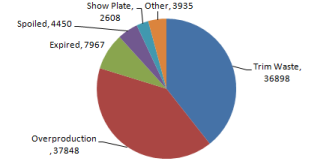
Source: Intel Corporation (2010, p.7)
The processes for producing food in the facilities consume a lot of water, land resources, and more importantly, energy. Affluent water constitutes some of the principle waste produced by the facilities. Waste materials at the facilities are also produced through food processing activities such as transportation, storage, and processing.
Waste materials composition includes biodegradable waste and non-biodegradable waste such as plastics and aluminium cans. Waste materials are normally collected in wastes bins before being hauled to the Oregon’s waste treatment plants.
Efforts to reduce waste production at both Corporation’s Ronler Acres Cafe 3 and Jones Cafe 5 has seen the Intel Corporation appoint waste administration personnel within its facilities headed by a senior chef. Under the new system, the organisation does not hire from outside its existing labour resources. The existing workforce takes individual responsibility to measure and record waste materials before disposal.
From the paradigms of labour costs, Intel Corporation (2010, p.5) notes that ‘in hypothetical operations at an hourly rate of $ 10, total labour cost in the waste reduction would be less than $30 per week’.
However, the system works without any additional dollars or even working hours for the existing employees. Instead of increasing labour, the waste management systems reduce labour requirements in the two dining facilities through the reduction of overproduction.
Results from the waste assessment
An interview with the workers and the management team provided important information on waste generation processes. An interview with the senior chefs at both Ronler Acres Cafe 3 and Jones Cafe 5 revealed that forecasting of menus to cut down waste is a major problem.
In particular, the chef for Ronler Acres Cafe 3 admitted that even in the light of the new system of waste management at his work place, low production forecasting is a major challenge. It may lead to failure of the facility to meet the orders of the day.
Jones Cafe 5 senior chef admitted the incompleteness of the waste management system to address challenges of management of some waste materials such as refuse vegetable oils, empty cans, and other packaging materials such as containers for hot beverages.
At both facilities, the management cited the problem of menu sophistication in contributing to the challenges of accurate forecasting of the raw material requirements to avoid waste production. The facilities kept on altering their menus to incorporate more of local and sustainable foods, which are highly perishable.
This move led to the production of more green waste. The pie-chart (circle graph) shown in fig. 2 below shows most discarded waste in the two dining facilities
Fig. 2: Pie chart showing most discarded waste at Ronler Acres Cafe 3 and the Jones Cafe 5
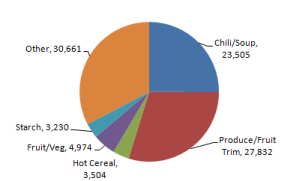
Source: Intel Corporation (2010, p.7)
Through the new pre-consumption waste management system, Ronler Acres Cafe 3 and Jones Cafe 5 have been in a position to reduce their waste production levels tremendously as shown in table 1 below.
Table 1: Waste reduction rate at Ronler Acres Cafe 3 and Jones Cafe 5
Source: Intel Corporation (2010, p.6)
Analyses of results
Amid the efforts of the Intel Corporation to minimise production of pre-consumer waste, both Ronler Acres Cafe 3 and Jones Cafe 5 still produce other forms of waste materials. Effective management of such waste can lead to immense reduction of costs of running the facilities.
One of the waste minimisation opportunities is to encourage customers to come with their hot beverages travel mugs. This move can help in reducing the amount of waste materials used for packaging hot beverages. The cost of each hot beverage-packing container is about 11% of the total cost each container of hot beverage served at the facilities.
By offering 10 % discount on equal quantities, of beverage served to customers having their own hot beverage travel mugs, will increase profit levels of the beverages by 1% while reducing the amount of plastic waste drastically.
This cost-saving and waste-reduction opportunity also includes additional saving on minimisation of transportation costs and the carbon dioxide emissions associated with transportation of the packaging containers to the facilities. Encouraging customers to come with their own travel mugs can assist in putting two trucks for hot beverage packaging containers out of the roads per week.
Both Ronler Acres Cafe 3 and Jones Cafe 5 discard many used vegetable oils. Instead of incurring costs levied on proper disposal of oil refuse from restaurants in Oregon, Ronler Acres Cafe 3 and Jones Cafe 5 can utilise the waste vegetable oil as cost-saving and waste-reduction opportunity.
Vegetable oils can be deployed in the production of electricity to supplement the Oregon’s State grid supply to the Ronler Acres Cafe 3 and Jones Cafe 5, and in the production of energy required in heating water. The utilisation of refuse vegetable oil in the production of electricity requires waste oil generator such as Vegawatt vegetable oil generator.
The generator can produce hot water from refuse vegetable oil at a capacity of 120 gallons in a week (Kaplan 2012). Picture 1 below shows an example of Vegawatt generator, which can be installed in a restaurant
Picture 1: Vegawatt waste vegetable oil generator
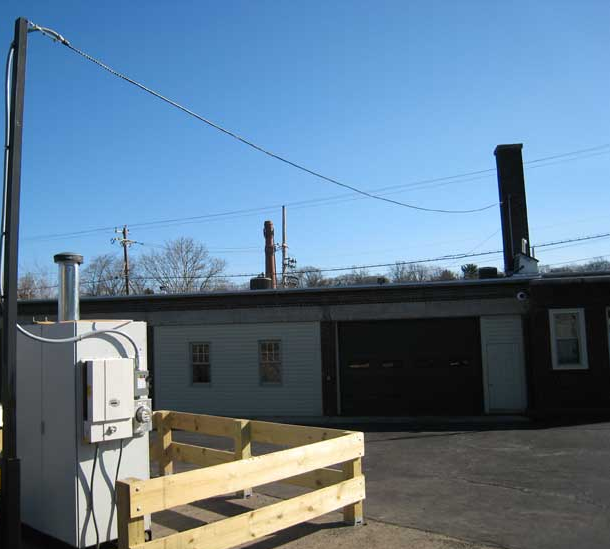
Source: Kaplan (2012, p.25)
Apart from the minimisation of energy consumption from the Oregon State’s grid, the generator does not introduce significant costs in terms of space utilisation. It is the size of two-door Samsung freezers sold in the commercial market. Its break-even time is four or even two years with a cost saving of $7,000 annually for smaller versions and $25, 000 for larger versions (Kaplan 2012).
Considering that Oregon’s department for environmental quality and the city of Hillsboro have high interest on giving incentives to organisations seeking to install systems for waste reduction and proper waste management, with such incentives, the payback period for Vegawatt waste oil vegetable generator can be reduced even to 6 months.
Waste recycling especially steel waste, plastic waste, and aluminium cans underscores another important cost-saving waste reduction opportunity. For effective implementation of this strategy, awareness on the need to dispose these waste materials appropriately is important. Consequently, Ronler Acres Cafe 3 and Jones Cafe 5 need to sensitise their consumers on the importance of proper waste disposal.
This goal can be achieved through the provision of waste bins for each type of waste at the exit of the facilities accompanied by signboards instructing customers to ‘put waste materials in their correct places.’ This move helps in reducing costs associated with sorting out waste materials.
From the cost-saving analysis, the general perception is that recyclable waste materials call for collection, sorting out, and then transportation to the manufactures of the products and then delivered back to Ronler Acres Cafe 3 and Jones Cafe 5 at reduced costs.
However, from a wider perspective, reducing the amount of virgin raw material required in the production of the materials translates in to reduced costs of production due to easiness of accessing cheaper raw materials (Myllymaa et al. 2005; Jenkins et al. 2003). Hence, the cost of repurchasing the products made from 100% recycled material also reduces at the two facilities.
Recommendations for waste minimisation
Ronler Acres Cafe 3 and Jones Cafe 5 should specifically aim at reducing post- consumption waste having successfully already minimised pre-consumption waste.
This strategy can help the two workplaces to save costs for running the facilities by an additional $80,000 per $1,000,000 worth of food produced as compared to the already achieved cost saving of $132, 000 per 1,000,000 worth of food produced through pre-consumption waste reduction strategies.
Future wastage minimisation strategies should focus on recycling, use of waste to produce inputs required in running the facilities such as power by making use of waste vegetables oil generators, and reduction of the amount of take-away foods and beverages packaging using containers, which cannot be reused to repackage without going through the recycling processes.
Implementation of the above-recommended practices requires the commitment of organisational resources in purchasing the required equipments and machineries such as Vegawatt generators and waste collection bins. Short-term strategies such as encouraging customers to come in with their packaging such as travel mugs require no resource planning and time. They are implementable immediately.
Recycling requires good administration of the waste collection process coupled with acquiring of waste collection bins. This recommendation is implementable within one year. Through funds obtained from the Oregon department for environmental quality and city of Hillsboro, purchasing of Vegawatt generators can be accomplished within the next six months.
Reference List
Bogner, J & Matthews, E 2003, ‘Global methane emissions from landfills: New methodology and annual estimates 1980-1996’, Global Biogeochemical Cycles, vol.17 no.11, pp. 34-48.
Gandy, M 1999, Recycling and the Politics of Urban Waste, Prentice Hall, London. Intel Corporation: Food Wastes Prevention 2011, Intel Corporation, Oregon.
Jenkins, R, Martinez, K, Palmer, K & Podolsky, M 2003, ‘The determinants of household recycling: a material-specific analysis of recycling program features and unit pricing’, Journal of Environmental Economics and Management, vol.45 no.2, pp. 294-318.
Kaplan, M 2012, ‘Restaurants Use Waste Oil for Power Generation’, Smart Planet, vol.11, no.7, pp. 21-34.
Myllymaa, H, Dahlbo, M & Ollikainen, S 2005, ‘A method for implementing life cycle surveys of waste management alternatives: environmental and cost effects’, Resources, Conservation, and Recycling, vol. 7 no.50, pp. 108-121.
Pipatti, R & Savolainen, I 2006, ‘Role of energy production in the control of greenhouse gas emissions from waste management’, Energy Conservation Management, vol.37 no.6, pp. 1105-1110.
Pipatti, R & Wihersaari, M 2008, ‘Cost-effectiveness of alternative strategies in mitigating the greenhouse impact of waste management in three communities of different size’, Mitigation and Adaption Strategies for Global Change, vol.2 no.1, pp. 337-358.
Price, J, 2001. ‘The landfill directive and the challenge ahead: demands and pressures on the UK householder’, Resources, Conservation, and Recycling, vol. 32 no.13, pp. 333-348.
World Bank: What a Waste – A Global Review of Solid Waste Management 2013. Web.

